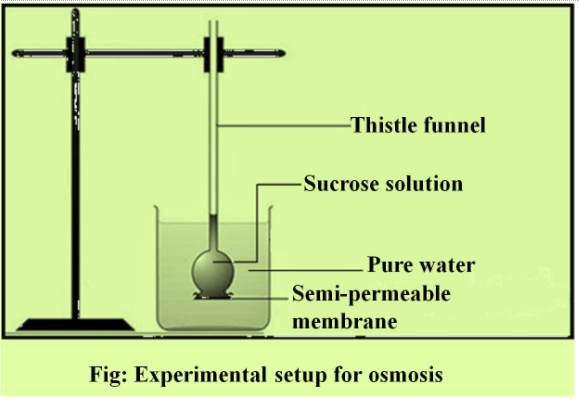
Answer
470.7k+ views
Hint: Osmosis refers to the diffusion of water across a differentially permeable or semipermeable membrane. A semipermeable membrane selectively allows the movement of a solvent while restricting the movement of solutes.
Complete answer:
The physiological demonstration of osmosis involves a semipermeable membrane tied to the mouth of thistle funnel, which is filled with sucrose solution. This semi-permeable membrane can be natural or artificial. The egg cell membrane is a natural semipermeable membrane while parchment paper is an artificial semipermeable membrane.
Additional Information:
This physiological demonstration of osmosis involves filling of a thistle funnel with sucrose solution and kept inverted in a beaker containing water. A semipermeable membrane acts as a barrier between the sucrose solution and pure water.
As osmosis involves the passive movement of water from a region of its high concentration to a region of its lower concentration, water will move into the funnel as pure water has the highest concentration of water and addition of any solute only decreases its concentration. This continuous movement of water from beaker into the funnel will result in a rise in the level of sucrose solution. This will continue until the equilibrium is reached.
Bell jar experiment proves that for any sound to propagate, it requires a material as its medium.

So, the correct answer is ‘both a and b.’
Note: Membranes can be impermeable, permeable, semi permeable or selectively permeable.
― Impermeable membranes don’t permit the entry of any solvent or solute. E.g. Lignified cell wall.
― Permeable membranes like a cellulosic cell wall allow all solute and solvents to pass through them.
― Selectively permeable membranes like plasma membrane and tonoplast allow only certain substances to pass through while preventing others.
Complete answer:
The physiological demonstration of osmosis involves a semipermeable membrane tied to the mouth of thistle funnel, which is filled with sucrose solution. This semi-permeable membrane can be natural or artificial. The egg cell membrane is a natural semipermeable membrane while parchment paper is an artificial semipermeable membrane.
Additional Information:
This physiological demonstration of osmosis involves filling of a thistle funnel with sucrose solution and kept inverted in a beaker containing water. A semipermeable membrane acts as a barrier between the sucrose solution and pure water.
As osmosis involves the passive movement of water from a region of its high concentration to a region of its lower concentration, water will move into the funnel as pure water has the highest concentration of water and addition of any solute only decreases its concentration. This continuous movement of water from beaker into the funnel will result in a rise in the level of sucrose solution. This will continue until the equilibrium is reached.
Bell jar experiment proves that for any sound to propagate, it requires a material as its medium.

So, the correct answer is ‘both a and b.’
Note: Membranes can be impermeable, permeable, semi permeable or selectively permeable.
― Impermeable membranes don’t permit the entry of any solvent or solute. E.g. Lignified cell wall.
― Permeable membranes like a cellulosic cell wall allow all solute and solvents to pass through them.
― Selectively permeable membranes like plasma membrane and tonoplast allow only certain substances to pass through while preventing others.
Recently Updated Pages
Fill in the blanks with suitable prepositions Break class 10 english CBSE

Fill in the blanks with suitable articles Tribune is class 10 english CBSE

Rearrange the following words and phrases to form a class 10 english CBSE

Select the opposite of the given word Permit aGive class 10 english CBSE

Fill in the blank with the most appropriate option class 10 english CBSE

Some places have oneline notices Which option is a class 10 english CBSE

Trending doubts
Fill the blanks with the suitable prepositions 1 The class 9 english CBSE

How do you graph the function fx 4x class 9 maths CBSE

When was Karauli Praja Mandal established 11934 21936 class 10 social science CBSE

Which are the Top 10 Largest Countries of the World?

What is the definite integral of zero a constant b class 12 maths CBSE

Why is steel more elastic than rubber class 11 physics CBSE

Distinguish between the following Ferrous and nonferrous class 9 social science CBSE

The Equation xxx + 2 is Satisfied when x is Equal to Class 10 Maths

Differentiate between homogeneous and heterogeneous class 12 chemistry CBSE




